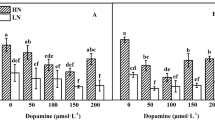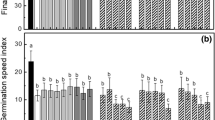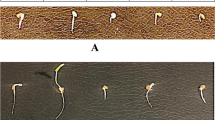Abstract
This study investigated the effects of varying calcium nitrate (Ca(NO3)2) supply on seed germination, seedling growth, and antioxidant responses during cucumber seed germination. Five and 20 mM Ca(NO3)2 stimulated seed germination, while 10 and 40 mM Ca(NO3)2 inhibited it. Germinating seed weight was clearly promoted by 5 mM Ca(NO3)2, but decreased under 40 mM Ca(NO3)2. Ten or 20 mM Ca(NO3)2 caused no marked change. Addition of 10 or 40 mM Ca(NO3)2 increased the activity of many enzymes in germinating seeds, such as superoxide dismutases (SOD), peroxidases (POD), catalase (CAT), ascorbate peroxidase (APX), glutathione reductase (GR), dehydroascorbate reductase (DHAR), and monodehydroascorbate reductase (MDHAR). On the other hand, 5 and 20 mM Ca(NO3)2 markedly decreased CAT activity. Among all the treatments, only 10 mM Ca(NO3)2 increased malondialdehyde content. Similarly, the production rate of O2.− was only higher in 20 mM Ca(NO3)2. Compared with the control (0 mM Ca(NO3)2), protein content significantly increased in all treatments except for 20 mM Ca(NO3)2. Calcium nitrate strongly inhibited the growth of seedlings, and damaged leaf and root microstructure. The inhibition and damage were more severe as the Ca(NO3)2 concentration increased. Calcium nitrate promoted the accumulation of photosynthetic pigment, but led to a decrease in chlorophyll a/b. These results suggest that the effect of different Ca(NO3)2 levels on seed germination was variable, while the inhibition effect on seedling growth enhanced with increase of Ca(NO3)2 concentration. This effect is closely associated with Ca 2+ and NO3- concentration, antioxidant enzyme activity, and the different growth and development stages of cucumber.
Similar content being viewed by others
References
Almansouri M, Kinet J-M, Lutts S (2001) Effect of salt and osmotic stresses on germination in durum wheat (Triticum durum Desf.). Plant Soil 231:243–254
Bradford MM (1976) A rapid and sensitive method for the quantitation of microgram quantities of protein utilizing the principle of proteindye binding. Anal Biochem 72:248–254
Cakmak I, Marschner H (1992) Magnesium deficiency and high light intensity enhance activities of superoxide dismutase, ascrobate peroxidase, and glutathione reductase in bean leaves. Plant Physiol 98:1222–1227
Ebert G, Eberle J, Ali-Dinar H, Lüdders P (2002) Ameliorating effects of Ca(NO3)2 on growth, mineral uptake and photosynthesis of NaCl-stressed guava seedlings (Psidium guajava L.). Sci Hortic 93:125–135
Egley GH, Paul JrRN, Vaughn KC, Duke SO (1983) Role of peroxidase in the development of water-impermeable seed coats in Sida spinosa L. Planta 157:224–232
Elstner EF, Heupel A (1976) Inhibition of nitrate formation from hydroxylammoniumchloride: a simple assay for superoxide dismutase. Anal Biochem 70:616–620
Fan HF, Du CX, Ding L, Xu YL (2013) Effects of nitric oxide on the germination of cucumber seeds and antioxidant enzymes under salinity stress. Acta Physiol Plant 35:2707–2719
Forde B, Lorenzo H (2001) The nutritional control of root development. Plant Soil 232:51–68
Foyer CH, Halliwell B (1976) The presence of glutathione and glutathione reductase in chloroplasts: a proposed role in ascorbic acid metabolism. Planta 133:21–25
Foyer CH, Noctor G (2005) Oxidant and antioxidant signalling in plants: a re-evaluation of the concept of oxidative stress in a physiological context. Plant Cell Environ 28:1056–1071
Foyer CH, Lelandais M, Kunert KJ (1994) Photooxidative stress in plants. Physiol Plantarum 92:696–717
Giannopotitis CN, Ries SK (1977) Superoxide dismutase I. occurrence in higher plants. Plant Physiol 59:309–314
Greenway H, Munns R (1980) Mechanism of salt tolerance in nonhylophytes. Annu Rev Plant Phyiol 31:149–190
He FF, Chen Q, Jiang RF, Chen XP, Zhang FS (2007) Yield and nitrogen balance of greenhouse tomato (Lycopersium esculentum Mill.) with conventional and site-speci-c nitrogen management in Northern China. Nutr Cycl Agroecosys 77:1–14
Heath RL, Packer L (1968) Photoperoxidation in isolated chloroplasts: I. Kinetics and stoichiometry of fatty acid peroxidation. Arch Biochem Biophys 125:189–198
Hossain MA, Nakano Y, Asada K (1984) Monodehydroascorbate reductase in spinach chloroplasts and its participation in the regeneration of ascorbate for scavenging hydrogen peroxide. Plant Cell Physiol 25:385–395
Huang H, Song SQ (2013) Change in desiccation tolerance of maize embryos during development and germination at different water potential PEG-6000 in relation to oxidative process. Plant Physiol Biochem 68:61–70
Kim YH, Khan AL, Waqas M, Shim JK, Kim DH, Lee KY, Lee IJ (2014) Silicon application to rice root zone influenced the phytohormonal and antioxidant responses under salinity stress. J Plant Growth Regul 33:137–149
Levin SA, Mooney HA, Field C (1989) The dependence of plant root: shoot ratios on internal nitrogen concentration. Ann Bot London 64:71–75
Misra N, Dwivedi UN (2004) Genotypic difference in salinity tolerance of green gram cultivars. Plant Sci 166:1135–1142
Nakano Y, Asada K (1981) Hydrogen peroxide is scavenged by ascorbate-specific peroxidase in spinach chloroplasts. Plant Cell Physiol 22:867–880
Nelson PV, Kowalczyk W, Niedziela JrCE, Mingis NC, Swallow WH (2003) Effects of relative humidity, calcium supply, and forcing season on tulip calcium status during hydroponic forcing. Sci Hortic 98:409–422
Park H-J, Miura Y, Kawakita K, Yoshioka H, Doke N (1998) Physiological mechanisms of a sub-systemic oxidative burst triggered by elicitor-induced local oxidative burst in potato tuber slices. Plant Cell Physiol 39:1218–1225
Sánchez E, Rivero RM, Ruiz JM, Romero L (2004) Changes in biomass, enzymatic activity and protein concentration in roots and leaves of green bean plants (Phaseolusvulgaris L. cv. Strike) under high NH4NO3 application rates. Sci Hortic 99:237–248
Scheible W-R, Lauerer M, Schulze E-D, Caboche M, Stitt M (1997) Accumulation of nitrate in the shoot acts as a signal to regulate shoot-root allocation in tobacco. Plant J 11:671–691
Tanou G, Molassiotis A, Diamantidis G (2009) Induction of reactive oxygen species and necrotic death-like destruction in strawberry leaves by salinity. Environ Exp Bot 65:270–281
Tong YW, Chen DF (1991) Study on the cause and control of secondary saline soils in greenhouses. Acta Hortic Sin 18:159–162
Veljovic-Jovanovic S, Kukavica B, Stevanovic B, Navari-Izzo F (2006) Senescence-and drought-related changes in peroxidase and superoxide dismutase isoforms in leaves of Ramonda serbica. J Exp Bot 57:1759–1768
Wei GP, Yang LF, Zhu YL, Chen G (2009) Changes in oxidative damage, antioxidant enzyme activities and polyamine contents in leaves of grafted and non-grafted eggplant seedlings under stress by excess of calcium nitrate. Sci Hortic 120:443–451
Yu BJ, Li SN, Liu YL (2002) Comparison of ion effects of salt injury in soybean seedlings. J Nanjing Agric Univ 25:5–9
Yuan LY, Du J, Yuan YH, Shu S, Sun J, Guo SR (2013) Effects of 24-epibrassinolide on ascorbate-glutathione cycle and polyamine levels in cucumber roots under Ca(NO3)2 stress. Acta Physiol Plant 35:253–262
Yuan LY, Shu S, Sun J, Guo SR, Tezuka T (2012) Effects of 24-epibrassinolide on the photosynthetic characteristics, antioxidant system, and chloroplast ultrastructure in Cucumis sativus L. under Ca(NO3)2 stress. Photosyn Res 112:205–214
Zhang GW, Liu ZL, Zhou JG, Zhu YL (2008) Effects of Ca(NO3)2 stress on oxidative damage, antioxidant enzymes activities and polyamine contents in roots of grafted and non-grafted tomato plants. Plant Growth Regul 56:7–19
Zheng GC (1979) Microscopic technology of biology. Popular Education Press, Beijing, China, p 110
Author information
Authors and Affiliations
Corresponding author
Rights and permissions
About this article
Cite this article
Fan, H., Ding, L., Xu, Y. et al. Seed germination, seedling growth and antioxidant system responses in cucumber exposed to Ca(NO3)2. Hortic. Environ. Biotechnol. 58, 548–559 (2017). https://doi.org/10.1007/s13580-017-0025-4
Received:
Revised:
Accepted:
Published:
Issue Date:
DOI: https://doi.org/10.1007/s13580-017-0025-4




